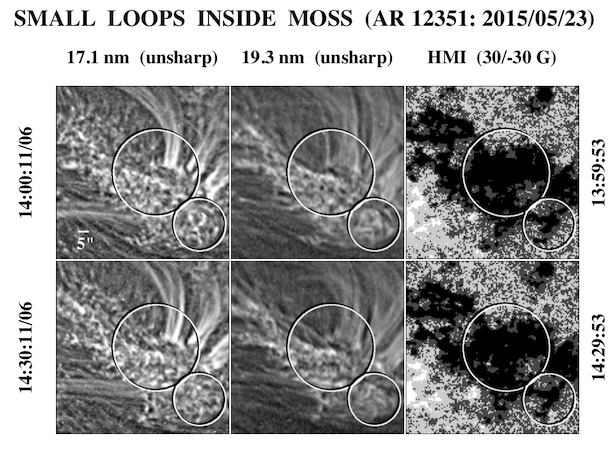Undetected Minority-polarity Flux, Moss, and Coronal Heating
| Nugget | |
|---|---|
| Number: | 432 |
| 1st Author: | Yi-Ming WANG |
| 2nd Author: | |
| Published: | 11 July 2022 |
| Next Nugget: | TBD |
| Previous Nugget: | Thermal/Nonthermal with MinXSS and RHESSI |
Introduction
The problem of maintaining the high temperature of the solar corona has obsessed solar physicists for decades. Many plausible mechanisms are possible, but we have definitely not arrived at a general consensus yet.
During the past few decades, the most popular models of coronal heating have involved the in situ deposition of energy, with footpoint shuffling giving rise to multiple current sheets (Parker's "nanoflare" model) and/or to MHD waves that dissipate in the corona. As pointed out in Ref. [1], observations suggest instead that the energy is released at low heights and transmitted to the corona by chromospheric evaporation, which accounts for the observed "overdensity" of coronal loops and their flat temperature profiles. These properties disagree with standard equilibrium models of magnetic loops embedded in the solar corona. This low-height behavior is also consistent with the presence of topologically complex structure near the footpoints of loops but not in their upper parts.
Until recently, a strong argument against footpoint magnetic reconnection as a major heating mechanism has been the near-absence of minority-polarity flux inside active region (AR) plages and strong magnetic network, according to even high-resolution magnetograms. Solar physicists describe large areas of field directed outward (or inward) at the photosphere as "unipolar", and the other polarity then is a "minority polarity." However, comparisons with EUV images suggest that magnetograms greatly underrepresent the amount of minority-polarity flux inside plages and other unipolar regions such as coronal holes.
Coronal Plumes
We first became alerted to the discrepancy between magnetograms and EUV images when studying the formation of coronal plumes using SDO data (Ref. [2]). The plumes were found to brighten as supergranular flows converged and brought network and internetwork elements together to form dense clumps, and to fade as the flows diverged. The Fe IX 17.1 nm images inevitably showed clusters of small loops inside the cores of the brightened plumes, but the HMI magnetograms sometimes showed no corresponding minority-polarity flux. Figure 1 gives a typical example.

Inverted-Y Structures Inside "Unipolar" AR Plages
Turning next to active-region plage areas, we identified numerous cases where the EUV images showed small, looplike structures with horizontal dimensions of 2-5 Mm, but no underlying minority-polarity flux was visible in the HMI magnetograms (Ref. [3]). Figure 2 displays examples of inverted-Y structures embedded inside "unipolar" plages. Because the footpoint loops have horizontal extents greatly exceeding the HMI pixel size, the failure to detect the minority-polarity flux is probably not simply the result of inadequate spatial resolution, but suggests a problem with instrument sensitivity in the presence of a strongly dominant polarity. One possibility is that scattering of radiation from the dominant polarity suppresses the weaker signal from the minority polarity.

The Nature of 17.1 nm "Moss"
In 17.1 nm images, plage areas have a spongy or reticulated appearance. This so-called "moss" is generally interpreted as the transition region of the overlying hot loops, with the interspersed dark "holes" representing chromospheric material. However, Figure 3 suggests that small, barely resolved loops are a major constituent of the brighter areas in the moss; such looplike fine structure is clearly visible (e.g.) inside the large circles in both the 17.1 and 19.3 nm images. Movies give the impression that the small loops are continually being churned by the underlying granular motions and continually reconnect with the overlying AR loops, giving rise to inverted-Y structures like those shown in Figure 2.
Moss-like structure is also observed outside AR plages, as within the small circles in Figure 3 and in the example shown in Figure 4. In these cases, mixed-polarity flux is clearly present under the moss, supporting the idea that the small curved features within it are indeed small loops.


Estimating the Energy Flux Associated with Footpoint Reconnection
Using SOHO/MDI magnetograms Ref. [4] finds that the emergence rate of "ephemeral regions" (ERs), defined here as magnetic bipole features having total magnetic fluxes of 1018-20 G/cm2, was at least 3 times lower inside unipolar areas than in mixed-polarity regions of the quiet Sun. However, based on the discrepancy between the magnetograms and the EUV images noted here, let us assume instead that the emergence or churning rate of small loops is the same everywhere on the Sun and given by that measured in the quiet Sun. Then the timescale for an equal amount of minority-polarity flux to emerge under a plage field of strength B ~ 300 G would be about 100 hr and magnetic energy would be dissipated at a rate sufficient to heat the AR corona (Ref. [5]). Similarly, reconnection between small-scale loops and the open flux inside coronal holes (B ~ 10 G) would yield an energy flux sufficient to drive the solar wind. In both cases, the energy release would be in the form of ohmic heating, jets, and MHD waves. Heat would be conducted downward from the reconnection site into the transition region, leading to chromospheric evaporation, which would fill the overlying AR loops with hot, dense material (as in solar flares) and drive the solar wind mass flux along open field lines.
Conclusions
Minority-polarity magnetism, undetectable at presen within apparently unipolar regions, can have major significance for our basic understanding of the solar chromosphere, corona, and solar wind. We ignore this at our peril!
References
[1] "The Coronal Heating Paradox"
[2] "Converging Supergranular Flows and the Formation of Coronal Plumes"
[3] "The Ubiquitous Presence of Looplike Fine Structure inside Solar Active Regions";
"Further Evidence for Looplike Fine Structure inside `Unipolar' Active Region Plages"
[4] "The Dependence of Ephemeral Region Emergence on Local Flux Imbalance"
[5] "Undetected Minority-polarity Flux as the Missing Link in Coronal Heating"